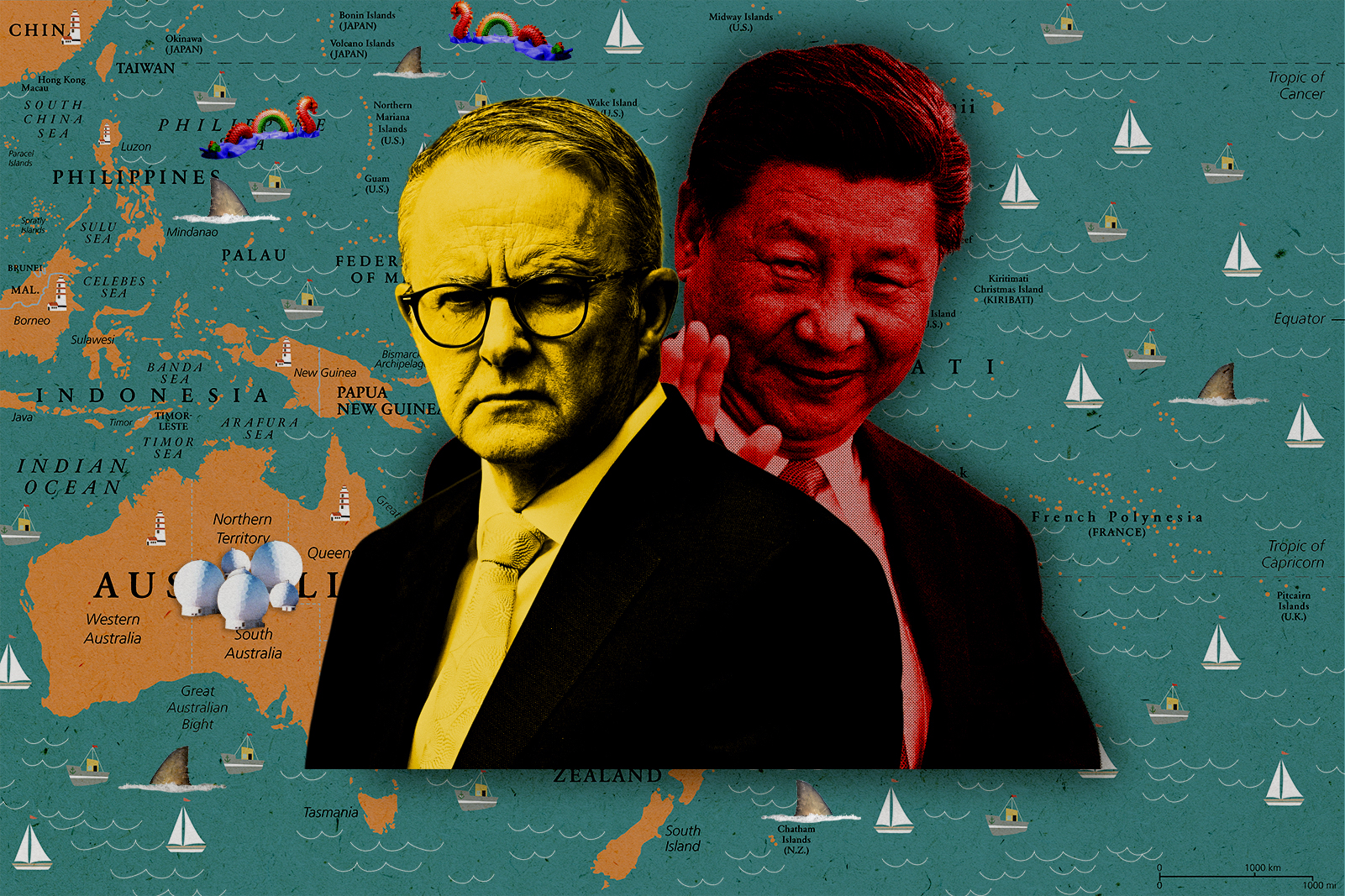
China and Australia are Playing Chess in the Pacific
In March 2022, the Pacific saw a notable geopolitical pivot as the Solomon Islands struck a security pact with China. Just five months prior, the Solomon Islands had enlisted Australia’s help to quell riots triggered by Honiara’s switch in diplomatic recognition from Taiwan to China. Canberra’s inability to safeguard Chinese assets during the upheaval paved the way for Beijing’s future intervention under the agreement. This instance underscores the intensifying tussle for geopolitical clout in the Pacific.
This agreement posed a direct challenge to Australia’s then-coalition government, elected on a strong national security platform. Consequently, two months later, Anthony Albanese, Australia’s new prime minister, embarked on a diplomatic mission to fortify regional relationships. Simultaneously, China’s top diplomat undertook a ten-day tour of eight Pacific nations, escalating the rivalry for Pacific diplomatic sway.
Australia’s foreign policy hinges on safeguarding its maritime interests via alliances with the United States, and exploiting its geographic seclusion for deliberate diplomacy. This approach, dating back to the 1940s, has sustained strategic alignment between Canberra and Washington despite a power imbalance.
Canberra crucially relies on Washington’s backing for national security interests. Thus, Australian policymakers amplify their strategic heft by offering the U.S. a platform for intelligence gathering and military operations, marked by interoperable forces and shared capabilities.
The Five Eyes intelligence alliance, AUKUS, the Quad, and ANZUS are all integral to Australia’s broader security framework. The Pine Gap facility in the Australian Outback is vital for U.S. intelligence gathering. The base monitors missile tests, manages drones, intercepts transmissions, and communicates with spy satellites. Additionally, the naval station at Northwest Cape relays data that enables U.S. naval vessels to track Chinese nuclear submarines – a strategic necessity in potential conflict situations. Further, the AUKUS pact, inked in 2021, will enhance the allied forces’ interoperability and furnish Australia with nuclear submarines, advanced cyber capabilities, and hypersonic missiles.
Though shared democratic values and cultural affinity bolster the alliance, it is essentially based on realpolitik. The price Washington exacts for assuming Australia’s defence is Canberra’s acquiescence to U.S. grand strategy. Consequently, Australia adopts a confrontational stance towards China.
Critics frequently assail this antagonism for jeopardising Australia’s economic interests, considering China is its largest trading partner. However, such criticism overlooks Canberra’s perception of its economic stance. Primarily, two-thirds of Australia’s China-bound trade comprises minerals for China’s construction sector. Australia, producing 900 million tons of iron ore annually – twice as much as second-placed Brazil – is confident that Chinese demand will endure despite geopolitical friction. In fact, some predict a surge in Chinese demand due to iron ore’s critical role in arms manufacturing as tensions mount.
Moreover, Canberra’s economic interests are deeply intertwined with those of Washington. Despite China’s economic clout making improved relations with Beijing desirable for businesses, fifteen of the top 20 ASX-listed companies were majority American-owned as of 2019, including four of the five mining firms. This ensures that Australian and American economic interests remain closely aligned.
While aligning with U.S. grand strategy, Australia actively pursues its unique strategic goals in the Pacific. Its maritime alliances and diplomatic initiatives have opened access to Fiji’s cotton crops, Nauru’s phosphate mines, and New Guinea’s gold and copper reserves. Therefore, the Pacific region is a lucrative frontier for Australian businesses, compelling Canberra to strive for a stable investment climate.
This imperative has triggered multiple instances of military intervention by Canberra. For instance, following the 1999 East Timorese crisis, Australia dispatched forces to stem pro-Indonesian militia violence, saving numerous lives. However, economic factors were strong motivators, as demonstrated when Australia leveraged its influence to negotiate a larger share of the greater Sunrise gas fields as the situation stabilized.
In a similar vein, in 2003, ethnic unrest led Canberra to intervene in the Solomon Islands – an intervention that lasted 14 years. Australia took over law enforcement, finance, and other governmental functions. At the end of the intervention, a bilateral security treaty allowed Australian military personnel to enter the Solomon Islands, at Honiara’s behest, and use force to safeguard Australian economic assets. This is why China’s Pacific strides are seen as intruding on Australia’s geopolitical sphere of influence.
However, Beijing, like Australia, also has strategic and economic stakes in play. Economically, Beijing’s interests closely mirror Canberra’s. Beijing seeks resources, investment prospects, and avenues for its state-owned corporations to secure them. Strategically, Beijing aims to breach Washington’s containment ring along the first island chain.
Beijing has thus endeavoured to gain access to airfields and ports in Kiribati, Vanuatu, and French Polynesia, and has established police and military links in Fiji, Papua New Guinea, and Tonga. It has also installed Pacific ground stations for its BeiDou satellite navigation system which, like its U.S. counterpart (GPS), can serve as a guidance system for missiles and other weapons. As it stands, Beijing’s influence in the region is confined to bilateral relations, with its attempts to propagate a regional economic security pact so far falling flat.
Australia has responded with countermeasures. For instance, when the Solomon Islands attempted to contract Huawei to construct an undersea Internet cable to Sydney in August 2017, Australia’s intelligence agency vetoed the deal, fearing Beijing could exploit the cable infrastructure for espionage. Consequently, Canberra built the cable and, in 2020, partnered with Tokyo and Washington to construct a similar cable linking Australia to Palau. Similarly, in 2019, when Papua New Guinea sought Beijing’s assistance in debt refinancing, Canberra offered a loan package worth $302 million.
That same year, Canberra responded to Beijing’s Belt and Road Initiative with the Pacific Step-up program. The scheme aimed to bolster regional sovereignty, stability, security, and economic prosperity, encompassing $1 billion in aid, $1.4 billion in infrastructure financing, and a labour mobility scheme providing Pacific nationals with work opportunities in Australia. Furthermore, Canberra founded the Australian Pacific Security College to train police and military personnel and awarded Telstra, a national telecom firm, $1.3 billion to buy Digicel Pacific, a mobile carrier active in six regional Pacific markets.
While economic assets, policing, infrastructure, and telecommunications continue to be sources of strategic competition, the Pacific Islands have not remained idle in the face of evolving geopolitical dynamics. Playing Beijing against Canberra affords Pacific Island nations considerable leverage in ensuring favourable outcomes. For instance, climate change is a pressing issue for the region. Kiribati, the Pacific nation with the lowest GDP per capita, is severely affected by rising sea levels. Given Australia’s coalition government’s dismissive stance on the matter, Kiribati inked 10 deals with China in 2022 and exited the Australian-dominated Pacific Islands Forum. This led Australia’s new labour government to pass an emissions reduction bill with the tacit aim of preventing similar actions from other Pacific Island nations.
Currently, East Timor is negotiating with Canberra to construct a pipeline from the Sunrise gas field to Darwin in Northern Australia. East Timor desires the liquified natural gas to be routed to the mainland for processing before its export to Australia to stimulate infrastructure.
On the grand chessboard of the Pacific, each move holds substantial geopolitical and economic consequences. For China, Australia, and the Pacific Island nations, the stakes could not be higher. The moves they make now will shape the future power dynamic in the region and determine who calls the shots in the Pacific for generations to come.

